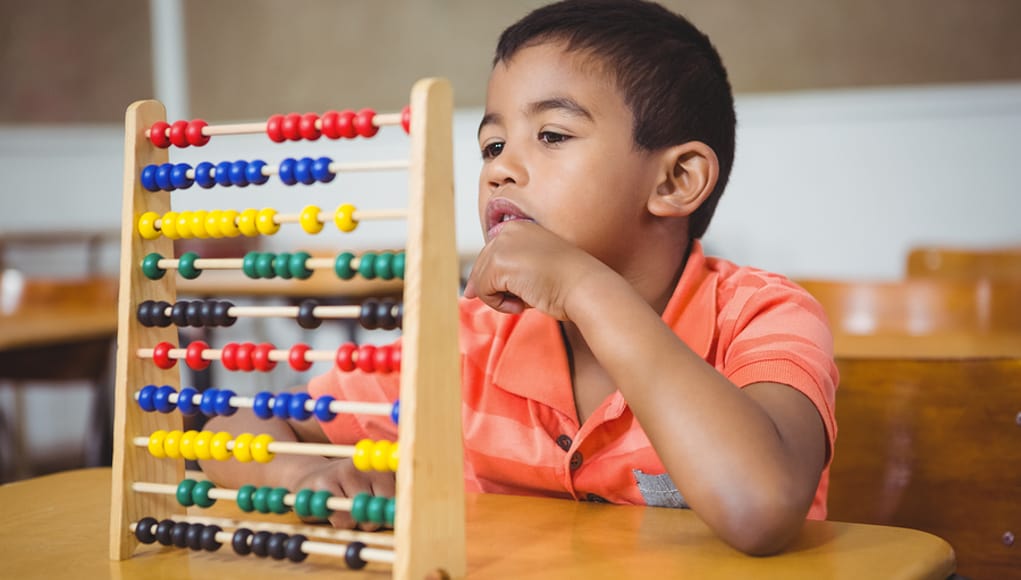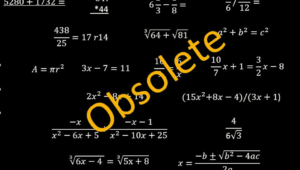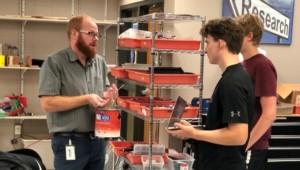Making in Math

Mathematics is a subject that is visual in nature. The website youcubed.org has an entire section dedicated to sharing visual activities and evidence from neuroscience about how the brain processes ideas. The timing of this research could not be better, considering the recent momentum that the maker movement has gained in education. Many schools have makerspaces or carts with supplies dedicated to giving kids the chance to tinker during school hours. While a makerspace is nice, it takes only some simple classroom supplies to start “making” in math. The process of making concrete objects can lead students to a deeper understanding of abstract concepts.
Do you find the word “making” overwhelming? Are you nervous about where to start? In my experience, integrating “making” into the math classroom does not have to be difficult or complicated. As a matter of fact, I find that it is best to start simple. Your students can become “makers” with simple supplies such as scissors, paper, rulers, string, and Play-Doh. Throw in a little bit of patience for the excitement and temporary mess that will likely consume your classroom as the kids dive in, and you are ready to get started.
What kind of “making” activities should you start with? Here are two simple suggestions.
1. Bring alive a standard textbook problem with “making”. Many math teachers can identify a few textbook problems that students typically struggle to understand. Asking students to build something that helps them visualize the foundation of the problem can deepen their understanding.
Example: The box problem
Variations of the following problem appear in many Algebra II, Pre-Calculus, and Calculus textbooks:
An 8.5-inch square piece of paper is used to make a box with a square base and no top. To make the box, cut out squares of the same size from each corner and fold up the sides. What are the dimensions of the box with maximum volume? (See the figure at right.)
This is a great example of a problem that can be brought to life with “making”. My experience is that many students struggle with visualizing the box implied by this problem. Without a visual to make sense of the problem, some students strictly focus on memorizing the algebraic solution.
Supplies needed: 8.5-inch square sheets of paper (you can make these yourself), scissors, rulers, and tape.
After introducing the word problem, I give each student a square sheet of paper, a pair of scissors, a ruler, and tape and tell them that we are going to make boxes. I randomly assign each student an “x-value” ranging from 0.5 inches to 3.5 inches and ask them to work in groups to create the boxes.
I am always amazed at what happens next: some students quickly make a box, but some students have no idea where to begin. I assign roles to students in each group — only one person in each group has a role that allows them to ask me group-approved questions. The result: students must work together to build the boxes. They help each other measure properly, draw cut-outs in the corners, fold up the sides, and tape the edges. As the completed boxes appear, the problem starts to come alive for the students. 
Now we bring in the math. What is your value of x? What is the volume of your box? I ask each student to enter their data into a live, shared spreadsheet which is projected on the board. As students enter data points, the spreadsheet plots the points. A graph with a clear maximum value slowly appears to the “oohs” and “aahs” of the class. As we work to create the algebraic volume formula and find the maximum volume, we now have many concrete visuals to consult. The boxes and graphs are visuals that students use to make sense of the abstract.
2. Use Play-Doh to visualize 3 dimensions. Many problems in Geometry, Algebra, and Calculus require students to visualize cross-sections of 3-dimensional objects from a 2-dimensional drawing. With some Play-Doh and patience, tough concepts can be transformed into ah-ha moments.
Example: Cross Sections
In my Geometry class, some students struggle to interpret 3D figures on a 2D page. We work with cross-sections early in the year to address this struggle. I give students 2D drawings of 3D objects and ask them to draw horizontal cross-sections of the objects at various locations. After reading a blog post about Play-Doh uses in education, I added Play-Doh to the activity, and it quickly became a class favorite.
Supplies needed: Play-Doh and thin string, like sewing string, to cut the Play-Doh.
I start by asking students to determine the shape of horizontal cross-sections of two cylinders, A and B (see picture at right). Most students are able to visualize the circular cross-sections of cylinder A, but some struggle to visualize the rectangular shape of the horizontal cross-sections of cylinder B.
I give each student a can of Play-Doh a piece of sewing string. They work to make a cylinder out of Play-Doh, and then use the string to cut various horizontal cross-sections of cylinders A and B. The classroom gets a little messy and a little loud, but the ah-ha moments are clear. We slowly move to more complex shapes that were inspired by a lesson from the Mathematics Assessment Project.



This “making” is simple but has powerful results. Students get to work with their hands to make shapes. As they work, they might decide to start over, volunteer to help a neighbor or determine that they no longer need the Play-Doh. Overall, students leave class feeling like they have a better understanding of visualizing cross sections. This activity takes a few class periods, but it is time well spent. As an extra bonus, this activity is a great lead-in to a 3D printing project.
Making in math can be simple and still have powerful results. Students are excited to do something different in math class and enjoy watching their objects come to life. Most importantly, the visual connections that they make to abstract concepts can deepen their understanding.
For more, see:
- A “National Math Storytelling Day” Story
- Helping Students Learn to Love Math Through Science
- Integrating the Engineering Design Process and Challenge-based Learning in STEM
Stay in-the-know with all things EdTech and innovations in learning by signing up to receive the weekly Smart Update.






0 Comments
Leave a Comment
Your email address will not be published. All fields are required.